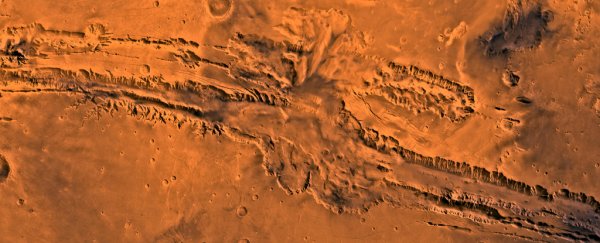One of the most intriguing features of Mars is the presence of quakes not unlike ones we get on Earth.
Since the start of 2019, planetary scientists have been logging these 'marsquakes' with a seismometer built into the InSight lander. Now, they've detected activity that points to the two largest marsquakes ever put on record.
These quakes are S0976a, a magnitude 4.2 event recorded on 25 August 2021, and S1000a, a magnitude 4.1 event that happened 24 days later. In terms of impact, they're both five times stronger than any previously logged marsquakes.
The location of these quakes is interesting too: they originated in the so-called shadow zone, the opposite side of the planet to where InSight is based. It's the first time the lander and its sensors have recorded a marsquake across such a huge distance.
 Mars surface relief map showing InSight's location (orange triangle) and S0976a (pink dot to the left). (Horelston et al., The Seismic Record, 2022)
Mars surface relief map showing InSight's location (orange triangle) and S0976a (pink dot to the left). (Horelston et al., The Seismic Record, 2022)
"Not only are they the largest and most distant events by a considerable margin, S1000a has a spectrum and duration unlike any other event previously observed," says planetary seismologist Anna Horleston, from the University of Bristol in the UK.
"They truly are remarkable events in the Martian seismic catalog."
The team described S1000a as a "clear outlier" in the quakes that have been recorded so far, because of the broad frequency spectrum of the energy it produced. It's also the longest-lasting seismic event InSight has monitored to date, lasting 94 minutes.
Seismic waves (known as PP waves and SS waves) were used to detect both S0976a and S1000a. These are waves that don't follow a direct path but are reflected at least once at the surface – which is how InSight was able to measure these rumbles from so far away.
In the case of S1000a, small amplitude waves that pass through the core-mantle boundary – called Pdiff waves – were also picked up. It's the first time InSight has logged Pdiff waves, and the signs are that the S1000a quake happened closer to the surface.
"[S1000a] has a frequency spectrum much more like a family of events that we observe that have been modeled as shallow, crustal quakes, so this event may have occurred near the surface," says Horleston.
"S0976a looks like many of the events we have located to Cerberus Fossae – an area of extensive faulting – that have depths modeled to be around 50 kilometers [31 miles] or more and it is likely that this event has a similar, deep, source mechanism."
Both marsquakes happened in the core shadow zone, a part of Mars where InSight can't track the P wave and S wave seismic activity directly. With S0976a, the team was able to place it within the giant Valles Marineris canyon network.
These canyons have previously been identified as places where quakes could happen, but this is the first time recordings have actually been made. The precise location of S1000a hasn't been established, but scientists know broadly where it happened.
Most of the quake activity recorded on Mars prior to these two events came from within about 40 degrees distance of InSight, but the latest data give scientists an opportunity to seismologically sample new parts of the red planet.
"Recording events within the core shadow zone is a real stepping stone for our understanding of Mars," says geophysicist Savas Ceylan, from ETH Zürich in Switzerland.
"Prior to these two events the majority of the seismicity was within about 40 degrees distance of InSight. Being within the core shadow, the energy traverses parts of Mars we have never been able to seismologically sample before."
The research has been published in The Seismic Record.
